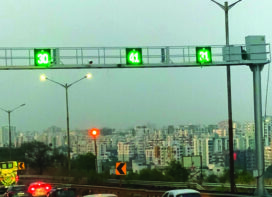To do away with the limitations of static scales (dharamkanta) which mean a cumbersome procedure, consumption of time and traffic jams, the weigh-in-motion technology seems to be finding favour with the enforcement agencies. Though the static scales promise to hold their ground for quite a few years, the WIM scales will change the way weighing machinery moved on the highways.
 Overloading of vehicles, mainly trucks and carriers, on the highways has been a cause of major concern for the government and of grave worry for the highway users. Not just because it leads to loss of revenue to the government when vehicles entering a state pay much less than what the weight they carry would require them to, but also because such severe overloading leads to major accidents on the highways, often fatal. Quite often, the vehicles (read trucks and trailers) carry weight which is 50-100% more than the permitted limit.
Overloading of vehicles, mainly trucks and carriers, on the highways has been a cause of major concern for the government and of grave worry for the highway users. Not just because it leads to loss of revenue to the government when vehicles entering a state pay much less than what the weight they carry would require them to, but also because such severe overloading leads to major accidents on the highways, often fatal. Quite often, the vehicles (read trucks and trailers) carry weight which is 50-100% more than the permitted limit.
Till a few years ago, the basic static scale (weighbridge, popularly called dharamkanta) was the only option available with the government wherein the enforcement agencies halted the vehicle, weighed its load, and charged the driver for the goods he was carrying. Extremely cumbersome, the process wasn?t always foolproof and often led to severe quarrels and fights between the scale operators and the drivers. Moreover, it led to constant traffic jams.
So, what is a weighbridge? The weighbridge is a huge set of scales that is permanently mounted on a concrete foundation. The vehicles are made to run on it to weigh the vehicle and its load. The vehicle is weighed with its load as well as without the load and the difference is calculated as its weight in terms of load cells. The weighbridge later had variations added to it as electronic weighbridges and portable weighbridges. There are also weighbridges that can be disassembled and re-assembled in a few hours. The process of using weighbridges still continues.
Over the years, a new technology began making its way to the weighing locations. In order to calculate the weight of the vehicle, this technology does not require the vehicle to come to a halt. Instead, the vehicle is weighed while it is in motion at a slow speed. The technology enables the capturing and recording of axle weights and gross vehicles when the vehicles cross a measurement site at a normal traffic speed or at reduced speed. If the vehicles carry weight under the permitted limit, they are not required to halt for inspection. They can just whizz past the toll plaza. With this technology, the process became efficient and calculation, more accurate. The technology is called Weigh-In-Motion or Weighing-In-Motion, referred to as WIM in short.
Says Aman Kishore, Managing Director, VaaaN Infra, ?WIM @ Toll concept has been in place in many developed and developing countries. The Low Speed WIM (LSWIM) scales are embedded in the pavement, about 25mtrs before the Pay Axis/Window, and as the truck slowly traverses over this structure, its per axle weight is calculated and the system automatically collates the per Axle Weight to provide the Gross Vehicle Weight (GVW)?.
 There is a huge investment towards capacity development but there is no focus towards capacity preservation. If we keep on developing but do not preserve or maintain, it will all rot. Initially, WIM was installed by the government at certain toll plazas at the outermost lanes but there was no enforcement ? it was only for data collection. They then began to understand the extent of overloading as the results were alarming. 70-80% of the trucks were overloaded by more than 100% of the weight limits the IRC (Indian Road Congress) has specified ? ten tons per axle. In the surveys we carried out, we found the loads were up to 23-24 tons per axle for many vehicles. On an average, the load was anywhere between 15-18 tons per axle. That means average overloading was between 50-80%.
There is a huge investment towards capacity development but there is no focus towards capacity preservation. If we keep on developing but do not preserve or maintain, it will all rot. Initially, WIM was installed by the government at certain toll plazas at the outermost lanes but there was no enforcement ? it was only for data collection. They then began to understand the extent of overloading as the results were alarming. 70-80% of the trucks were overloaded by more than 100% of the weight limits the IRC (Indian Road Congress) has specified ? ten tons per axle. In the surveys we carried out, we found the loads were up to 23-24 tons per axle for many vehicles. On an average, the load was anywhere between 15-18 tons per axle. That means average overloading was between 50-80%.
? Aman Kishore
The driver of a truck found to be carrying load in excess of the permitted limit is made to offload the extra weight at a warehouse nearby and return later to carry the surplus good after paying a penalty. Of course, the process of making WIM feasible is still on and it will take a while before it becomes a norm.
 The Weigh-in-Motion technology is non intrusive and does not require manual labour in the entire weight-checking process ? it gives automated real-time data from a distance. By the time the vehicle reaches the plaza, its calculated weight has already reached the operators. Often, the technology involves wireless communication, remote camera, licence plate reader, electronic transponders and even optical character recognition (OCR) cameras. There are various sub-technologies within the WIM technology. However, the performance of each would depend on the condition and the configuration of the road. The condition of the vehicle and the actual site too will play a part. The performance will vary a little depending on the technology used too.
The Weigh-in-Motion technology is non intrusive and does not require manual labour in the entire weight-checking process ? it gives automated real-time data from a distance. By the time the vehicle reaches the plaza, its calculated weight has already reached the operators. Often, the technology involves wireless communication, remote camera, licence plate reader, electronic transponders and even optical character recognition (OCR) cameras. There are various sub-technologies within the WIM technology. However, the performance of each would depend on the condition and the configuration of the road. The condition of the vehicle and the actual site too will play a part. The performance will vary a little depending on the technology used too.
The static scale gives more or less the same measurement since the force of the axle, the axle group or the vehicle placed on the scale is constant on the motionless scale. The most important factor in determining the load here is the scale and its performance. Accuracy can be arrived at with repeated testing and calibrating for each vehicle. It is still relied upon by many authorities and at many places. With the WIM Technology though, came efficiency in weight measurement. Hence, the demand for the WIM scales and sensors too has been on the rise. Many companies in India are now supplying the Weigh-in-Motion equipment. VaaaN Infra, Kistler, Tollman, L&T, IRD South Asia and CMS are a few of them.
 TrafficInfraTech Magazine Linking People Places & Progress
TrafficInfraTech Magazine Linking People Places & Progress


